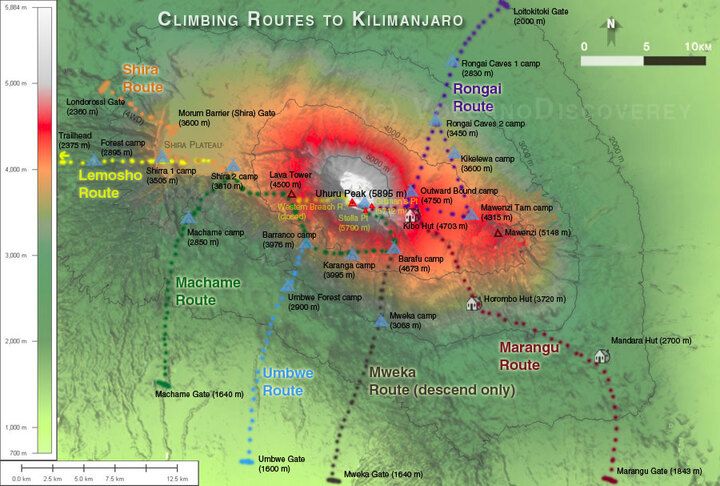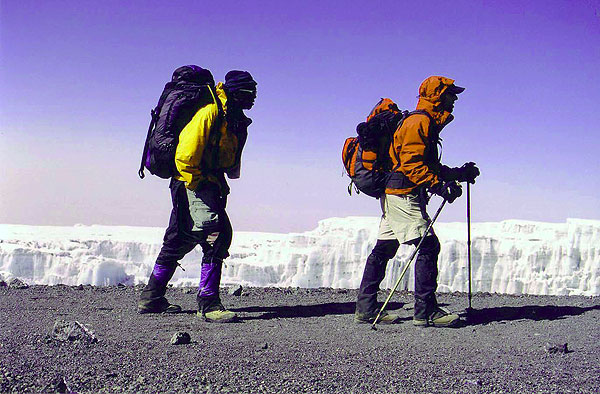
There are six major ascent routes leading up from the feet of Kilimanjaro and most of them merge at some stage: counted anti-clockwise and beginning with the westernmost trail, these are: the little-used Shira Route, the Lemosho Route, Machame Route, Umbwe Route, Marangu Route and, running from the north, the Rongai (Loitokitok) Route. All of them eventually meet a path circling the foot of the Kibo cone, known as the Northern and Southern Circuit.
While there are many options to start the climb, there are only 3 common routes leading up to the summit crater of Kibo and all ascend routes merge into one these: from west to east, the Western Breach Route (also known as the Arrow Glacier Route) via the Western Breach (currently closed), the Barafu Route via Stella's Point or the route via Gillman's point. The Western Breach and Barafu routes in the south can be used by trekkers coming from the Shira, Lemosho, Machame or Umbwe Routes, while climbers on the Marangu and Rongai Routes usually take their final ascend via Gillmans Point.
The most popular routes on Kili are the Machame (the most popular one in 2006), followed by the Marangu and Rongai routes. Although we outfit climbs for all routes on Kilimanjaro, we prefer the more scenic and less touristed routes such as the Lemosho Glades (also known as the Shira route), Rongai and the Umbwe route.
For those with time to acclimatize properly, we recommend to stay at the summit in the so-called Crater Camp, which is best done in combination with the Lemosho or Shira routes. It is the most expensive, but also most exclusive option to experience Kibo. It should be attempted only after sufficient acclimatization time,- you should plan at least 8 days, better 9 days on the mountain. The big advantage of camping one night in the crater is that it gives you the opportunity to explore the fascinating summit area with its glaciers and the inner, concentric crater,- the Reusch crater with the innermost crater nested in it, the Ash Pit - a truly world-class experience few people can do.


There are many routes to climb Kili, and it is not easy to pick one. As a general rule, the more days on your climb the better! You will have better acclimatization, less risk of altitude sickness and more time to enjoy the many unique features of the mountain.
Since there are only 3 possible final approaches to the summit, it is good to think about your final ascent route first. Another important point to consider would be to determine how you want to spend your time at the summit itself. An interesting option could be climbing the crater during the day and plan a camp in the crater. However, this asks for a sufficiently long acclimatization time, possible from 8 day itineraries on.
Rongai or Marangu routes approach the summit via Gillman's Point (5712 m). This approach is usually done at night, because after the hard climb to reach Gillman's Point it is still 2 hours to the summit.
The Stella Point (5790 m) approach is used on the Umbwe, Machame, Lemosho and Shira routes. From Stella Point the summit Uhuru Peak (5895 m) is only one hour away. This approach is mostly climbed at night, but we also offer variations where you climb it during the day, usually incombination with a crater camp.
On the most westerly and most challenging route the summit is reached via the so-called Western Breach, a collapsed section of Kibos crater rim. This approach can be done on the Umbwe, Machame, Lemosho, and Shira Routes.
The WB climb is best attempted during daylight hours, both because it it requires extra caution and because it allows you to enjoy the breathtaking scenery in this area. It should only be attempted by experienced hikers and climbers, and best be avoided during the rainy season (April-May and November).
Although very rare, dangerous rockfalls can occur on this route and several climbers died on Jan 4, 2006 during a large rock slide. Field investigations are under way, but for the time being this route is closed.